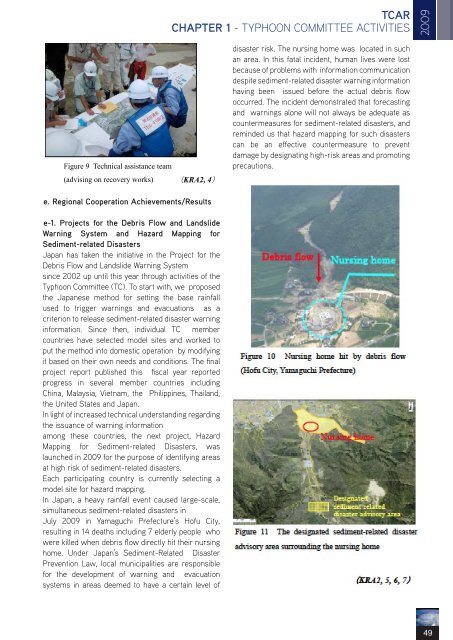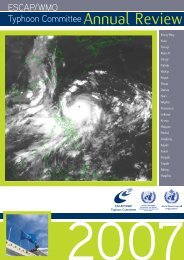TCAR - Typhoon Committee
TCAR - Typhoon Committee
TCAR - Typhoon Committee
You also want an ePaper? Increase the reach of your titles
YUMPU automatically turns print PDFs into web optimized ePapers that Google loves.
Figure 9 Technical assistance team<br />
(advising on recovery works) (KRA2, 4)<br />
e. Regional Cooperation Achievements/Results<br />
e-1. Projects for the Debris Flow and Landslide<br />
Warning System and Hazard Mapping for<br />
Sediment-related Disasters<br />
Japan has taken the initiative in the Project for the<br />
Debris Flow and Landslide Warning System<br />
since 2002 up until this year through activities of the<br />
<strong>Typhoon</strong> <strong>Committee</strong> (TC). To start with, we proposed<br />
the Japanese method for setting the base rainfall<br />
used to trigger warnings and evacuations as a<br />
criterion to release sediment-related disaster warning<br />
information. Since then, individual TC member<br />
countries have selected model sites and worked to<br />
put the method into domestic operation by modifying<br />
it based on their own needs and conditions. The final<br />
project report published this fiscal year reported<br />
progress in several member countries including<br />
China, Malaysia, Vietnam, the Philippines, Thailand,<br />
the United States and Japan.<br />
In light of increased technical understanding regarding<br />
the issuance of warning information<br />
among these countries, the next project, Hazard<br />
Mapping for Sediment-related Disasters, was<br />
launched in 2009 for the purpose of identifying areas<br />
at high risk of sediment-related disasters.<br />
Each participating country is currently selecting a<br />
model site for hazard mapping.<br />
In Japan, a heavy rainfall event caused large-scale,<br />
simultaneous sediment-related disasters in<br />
July 2009 in Yamaguchi Prefecture’s Hofu City,<br />
resulting in 14 deaths including 7 elderly people who<br />
were killed when debris flow directly hit their nursing<br />
home. Under Japan’s Sediment-Related Disaster<br />
Prevention Law, local municipalities are responsible<br />
for the development of warning and evacuation<br />
systems in areas deemed to have a certain level of<br />
<strong>TCAR</strong><br />
CHAPTER 1 - TYPHOON COMMITTEE ACTIVITIES<br />
disaster risk. The nursing home was located in such<br />
an area. In this fatal incident, human lives were lost<br />
because of problems with information communication<br />
despite sediment-related disaster warning information<br />
having been issued before the actual debris flow<br />
occurred. The incident demonstrated that forecasting<br />
and warnings alone will not always be adequate as<br />
countermeasures for sediment-related disasters, and<br />
reminded us that hazard mapping for such disasters<br />
can be an effective countermeasure to prevent<br />
damage by designating high-risk areas and promoting<br />
precautions.<br />
2009<br />
49

















